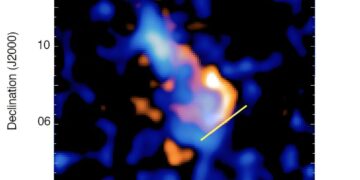Galaxy clusters are among the largest structures in the universe, offering unique opportunities to study cosmic phenomena on an unparalleled scale. Recently, an international team of astronomers investigated a fascinating galaxy cluster merger, CIZA J0107.7+5408 (CIZA0107), using the Very Large Array (VLA).
Understanding Galaxy Clusters and Mergers
What Are Galaxy Clusters?
Galaxy clusters are vast assemblies of galaxies held together by gravity. Each cluster can contain thousands of galaxies, hot ionized gas, and dark matter, all interacting in a complex gravitational dance. Clusters grow by merging with smaller groups or accreting sub-clusters, creating intense conditions that cannot be replicated in any terrestrial laboratory.
Why Study Mergers?
Merging galaxy clusters like CIZA0107 provide a unique window into the behavior of matter under extreme conditions. These environments offer clues about shock waves, turbulence, and the distribution of dark matter. The energy released during mergers influences the properties of the intra-cluster medium and drives phenomena such as cosmic ray acceleration and the formation of large-scale magnetic fields.
CIZA J0107.7+5408: A Post-Core Passage Merger
The Unique Characteristics of CIZA0107
Located at a redshift of approximately 0.1, CIZA0107 is a dissociative binary cluster merger. It consists of two subclusters, each with distinct optical density peaks and associated but offset X-ray emission peaks. This configuration indicates a complex dynamical state, with the clusters still in the process of interacting and settling.
Observational Campaign
A team of astronomers led by Emma Schwartzmann from the U.S. Naval Research Laboratory conducted multi-frequency observations of CIZA0107 using the VLA. The campaign focused on imaging the cluster’s diffuse radio emissions and mapping its spectral index distribution, shedding light on the intricate processes occurring during the merger.
Key Findings from the Study
Diffuse Radio Emissions
The VLA observations revealed diffuse radio emissions extending across both subclusters, spanning approximately 1.6 million light-years in scale. These emissions provide critical information about the underlying processes driving the merger, including the interaction between charged particles and magnetic fields.
Spectral Index Distribution
The researchers measured spectral indices for the two subclusters, finding values around -1.3, consistent with the presence of synchrotron radiation from relativistic electrons. Additionally, ultra-steep spectrum regions were identified in the northwestern and southeastern areas, with slopes of -2.2 and -2.9, respectively. These findings suggest the presence of aged electron populations or re-accelerated particles.
Unusual Features
The study uncovered several intriguing phenomena:
- Sharp Radio Edge: At 340 MHz, a distinct radio edge was observed in the southwestern subcluster, aligning with an X-ray shock front. Surprisingly, this feature was absent at 3.0 GHz, where the emission extended beyond the shock.
- Double Halo Structure: The properties of the diffuse emission suggest that CIZA0107 may host a double halo structure, or the observed emission could originate from two relics projected onto the cluster’s central regions.
Implications of the Findings
Galaxy Cluster Evolution
The observations of CIZA0107 contribute to our understanding of how galaxy clusters evolve during mergers. By studying the distribution of matter and the behavior of radio emissions, researchers can infer the dynamics of the merger and its impact on the intra-cluster medium.
Cosmic Ray Acceleration
The spectral indices and ultra-steep spectrum regions indicate processes related to cosmic ray acceleration. These findings provide valuable insights into how charged particles gain energy in such extreme environments, shaping our understanding of high-energy astrophysics.
Dark Matter and Shock Fronts
The alignment of radio and X-ray features highlights the role of shock fronts in galaxy cluster mergers. These structures offer a unique opportunity to study the self-interaction properties of dark matter and the mechanisms that govern its distribution.
The Role of Advanced Observations
Why the VLA?
The Very Large Array’s cutting-edge technology enabled high-resolution imaging of CIZA0107’s radio emissions across multiple frequencies. This level of detail is crucial for disentangling the complex interactions within merging clusters and identifying features that would otherwise remain hidden.
Multi-Frequency Advantage
Combining observations at different frequencies allowed researchers to map the spectral index distribution and identify unique features such as the sharp radio edge. This approach enhances our ability to interpret the data and draw meaningful conclusions about the physical processes at play.
Broader Implications for Astronomy
Expanding Our Knowledge
The findings from CIZA0107 are not isolated but contribute to a growing body of research on galaxy cluster mergers. Each study helps refine theoretical models, improving our understanding of cosmic phenomena on the largest scales.
Applications to Cosmology
By studying the behavior of dark matter and baryonic matter during mergers, astronomers can gain insights into the fundamental forces shaping the universe. These observations also inform models of large-scale structure formation, bridging the gap between theory and observation.
Technological Innovations
The success of this study underscores the importance of advanced observational tools like the VLA. Future telescopes, including the Square Kilometre Array (SKA), promise to further revolutionize our understanding of galaxy clusters and their role in the cosmos.
Conclusion
The study of CIZA J0107.7+5408 offers a glimpse into the dynamic and fascinating processes that govern galaxy cluster mergers. Through detailed observations and innovative techniques, astronomers have unveiled the complex interplay between matter, energy, and dark matter in this extraordinary system.



















